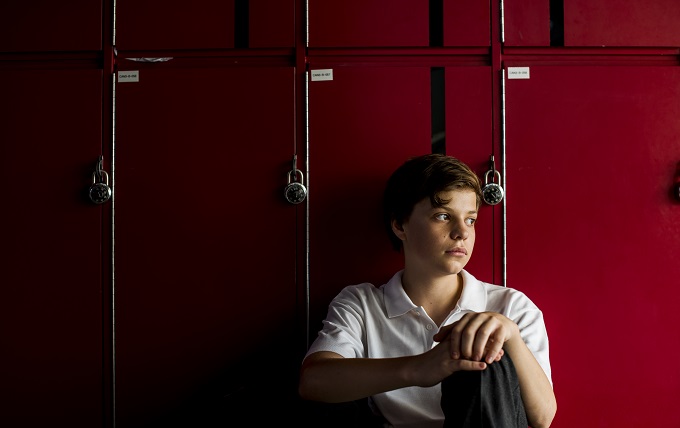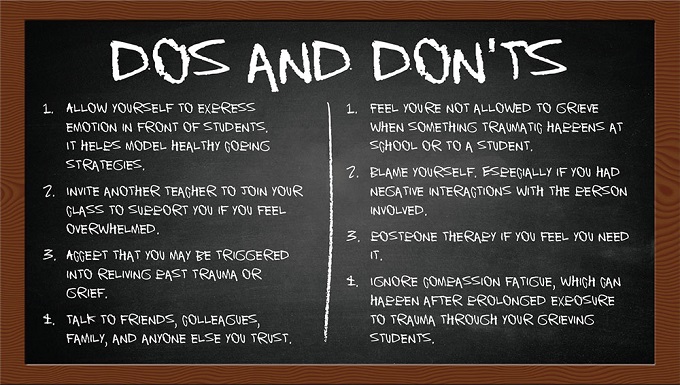What do I say? “Dead, dying, death.”

Grief is part of life but for teachers, it’s also part of the job that rarely gets talked about.
What do you say to students after a death in their family, or in your school community?
This is the question that School News has received from multiple teachers in the last six months, so it’s a question we took to relevant bodies on a quest to find some answers.
This article was written for our recent Term 1 issue – did you receive your copy? Check out the online version here.
Death, trauma and even suicide can, and likely will, invade the culture of every school in some way at some point and while the Ministry of Education provides plenty of resources for schools, these often centre around school management. For classroom teachers who are interacting with children on a daily basis, grief has many faces.
At any given time, teachers can experience feelings of pressure to identify at-risk kids, confusion around language and not knowing what to say to grieving students. Teachers have also expressed reluctance to engage in conversations about grief and mental health with students in fear of ‘saying the wrong thing’ or getting in trouble with school authorities. Above all, teachers have told us they struggle to strategise around suicide and suicidal ideation.
Out of respect for privacy, School News has not named or identified any of the teachers or schools included in this article.

When something traumatic happens
The Ministry of Education’s advice for schools regarding grief is more broad and focusses on principals, school leaders and pastoral care. First, they do not employ grief counsellors or provide counselling. They can refer schools to relevant specialists that individuals can access through CAFS/CAHMS but funding for whole school counselling by a visiting psychologist or qualified grief counsellor, particularly after a suicide has taken place, is not common.
As Skylight resource centre coordinator Raewyn Hewitt explains: “In New Zealand, school counsellors often deal with issues that arise for the students within their schools. Where necessary, students are referred for external counselling. There is very little public funding available for counselling for those impacted by suicide. Often regional funding is accessed, or a GP may be able to access funding by making a referral to local mental health providers (CAHMS).”

Schools are encouraged to designate a ‘support room’ where upset students and teachers can attend when overwhelmed. Secondary school guidance counsellors are encouraged to be proactive in supporting vulnerable or at-risk individuals. Primary schools do not have their own guidance counsellors, so they are encouraged to see if guidance counsellors from nearby secondary schools can be released to support vulnerable students. It should be noted though, that school guidance counsellors are not always qualified in the specific area of grief and loss, although training does exist.
When asked about funding for grief counselling, the Ministry confirmed that it doesn’t employ grief counsellors. Deputy secretary of sector enablement and support, Katrina Casey spoke more broadly: “Schools are in a unique position where they can to work with the community to help improve and support young people’s wellbeing. They can be places of safety, stability and security where young people can experience connection and belonging that supports their development.”
Practically, when a traumatic incident occurs within a school community, principals should reach out to a traumatic incident team. There is a team located at each of the MoE’s 10 regional offices. These teams are comprised of trained professionals who are able to “provide advice and support to schools that experience traumatic events to ensure that they receive the support they need for as long as it is needed”. According to Katrina: “The team frequently consists of psychologists and special education advisors. Depending on the nature of the incident, the team may also include education advisors like kaitakawaenga (Māori Liaison Advisors) or other Ministry and/or external agency staff.”
While ‘traumatic incidents’ incorporate a wide range of things, the type of traumatic incident that School News has received the most questions and concerns about from teachers, is suicide. So let’s talk about student suicide: how to respond, how to prevent and how to better identify at-risk young people.
Why you can’t say ‘suicide’
“Legally,” explained Ms Hewitt, schools “can only refer to a ‘suspected suicide’ until the coroner has made a ruling”. Schools are also “prohibited from discussing the method a person may have taken their own life.
“It is helpful to be very matter of fact about the fact that the person has died, and how very sad that is; especially for their family and people close to them. Answer children’s questions honestly but provide a safe framework that doesn’t focus on the how it happened, but how we can respond.”
Educational psychologist Michele Blick noted: “The term used in the school setting is ‘unexpected sudden death’ and it is advised to discourage speculation about the cause or details of the death.” It is especially difficult for teachers to mitigate rumours about cause of death in situations where social media is involved, or students have prior knowledge of the incident before the school responds. One teacher informed School News that they found rumours difficult when students had been communicating with a student immediately prior to their death. In this situation, the students felt they knew a lot more about the situation than teachers did.

To contain rumour and emotional response, the Traumatic Incidents team advised schools to avoid telling large groups of students at once in an assembly setting. Organising smaller groups will mitigate rumours and limit any “emotional ripple effect”. Staff should speak with small groups of the most affected students first.
The team also specifies that teachers should “tell close friends of the victim in private, allowing them time to be together to support each other away from the public eye”, then “have familiar teachers/deans inform students in their class or home room rather than all together at an assembly”. “An exception to this might be a rural school with a small roll and only one or two teachers, or a Māori immersion school where all are considered whānau.”
Teachers, guidance counsellors and all staff members should be on the lookout for students who appear more deeply impacted by the news, and record all communications and concerns. Any students identified as at-risk should be logged on a ‘care-register’. The register should show the date and time the student’s name was entered, any perceived risks, when and what was done about the risks, what the outcome was, as well as when and why the student’s name was removed from the register.
Never say ‘passed away’
Specialist bereavement counsellor Dr Dianne McKissock explains: “We use explicit language always, not euphemisms.” She clarified that “avoiding words like ‘death, dying and dead’ tend to convey that death is so scary that we can’t even give it a specific name”. In primary school, she noted: “Young children have no idea what we are talking about when we say things like ‘passed away’ or, even worse, ‘passed’.”
She also told us that she frequently reads speech drafts by email for teachers in New Zealand and Australia to suggest changes as necessary and this is the type of support that schools can also access through the Ministry of Education’s Traumatic Incident team.
Write a script but prepare for impromptu questions
A script can provide an outline for school staff about what they are allowed to say. However, a scripted speech alone will not be enough for all students, so questions should be expected. Auckland-based educational psychologist Michele Blick advised that while a script is recommended for schools to plan a consistent response, it’s important to remember that senior management will usually be the ones to read from this script. For class teachers, a script alone probably won’t be enough.

“If a student has ended his/her life, in consultation with whanau, the school will plan a consistent response. Next steps and the information shared is often a result of working closely with whanau. It is recommended that a script is prepared so all staff are aware of the information that will be delivered. This message may be delivered at a whole school assembly, with one class, a small group or key individuals. Senior management will often deliver this information. If a teacher is asked direct questions by a student, the teacher can repeat the agreed script or refer these questions to management for a response.
“After a traumatic event, it is important to support resilience and minimise risk of contagion. Provide opportunities for students to express their emotions and support them to identify healthy ways to manage their feelings. Teachers need to monitor at-risk students in their class and notify designated staff of any concerns.”
In its guidelines for traumatic incident response, the Ministry of Education has advised: “The script provided to teachers should include the facts about what has happened, what the school is doing to support the family, what students can do to support each other and that if they have questions or are concerned about anyone they need to talk to their teacher. Information given to students should normalise responses to trauma and offer techniques for basic coping and stress management. For younger children the concept and understanding of death may not be fully developed – be prepared for tricky questions that will need to be answered truthfully.”
‘How did they die, Miss?’
This, and other uncomfortable questions could be raised suddenly during class time, particularly if students are not given the appropriate space and time to ask questions, so teachers should be prepared to respond calmly, letting students know that knowing the ‘how’ doesn’t change the fact of their death. Ideally, schools will organise structured sessions for small groups of students who are likely to be most affected so that they can receive honest but appropriate answers. This may help prevent class teachers from receiving uncomfortable questions during lessons, and stem the spread of rumours.
Getting into more depth about how to navigate these tricky questions, Dr McKissock elaborates: “Truth and inclusion help young people to integrate painful events in their lives. But first I should clarify that truth means ‘access to truth’ and awareness of being in a truthful environment. Access to truth means that students know that all questions are permissible, and that they will be given truthful answers in appropriate language. This doesn’t mean being given facts in a way that is unnecessarily confronting.
“Rumours are best addressed and better contained in a structured setting. For example, a group of students most affected by the death, and facilitated by two teachers, or a teacher and the school counsellor, could stop the spread of gossip.
“The facilitator could begin by stating what they all know, for example, ‘we are all here because X has died and we are affected by his death. Many of you know the manner of his death, but for those who don’t, you can ask questions and we will give explanations as simply as possible. Once questions have been answered, we will all share our thoughts and feelings and talk about ways of managing our distress. After this time together we hope that you will all contribute to stopping the spread of gossip. Each time a story does the rounds it tends to gather details that are often incorrect and can cause alarm to the listener, and unimaginable distress to the family of the person who died. Who has the first question?’”
In the classroom, Ms Hewitt continues: “A teacher can set the tone for the conversations without going into the detail. For example, ‘As many of you may have heard X died last week. You may have heard people talking about how that happened. I can understand that you might be curious about that. But knowing that won’t change the fact that they died. Or change how incredibly sad we feel about it’, This could be the opening for a discussion about grief, how it feels, and how we can support ourselves and other people when we are grieving.
“It is worth remembering that there may be other children in the group that may have been having suicidal feelings, or may have been impacted by suicide, so it is important to stress the need for everyone to be really sensitive to feelings.
“For this reason if a child asks directly what suicide is, ask them to talk to an adult, or come and speak privately with you afterwards. It is important that the adults feel comfortable fielding these questions.”










